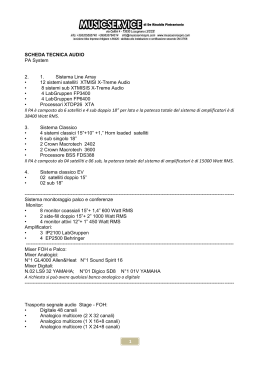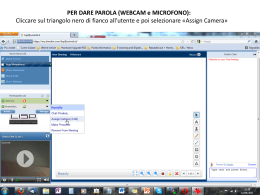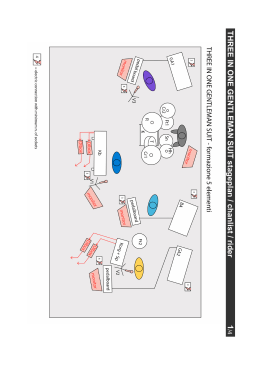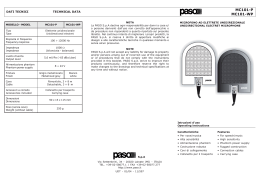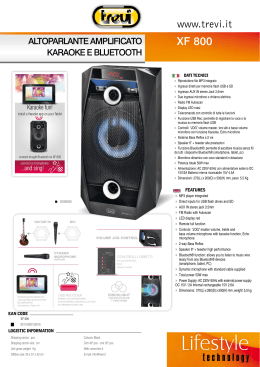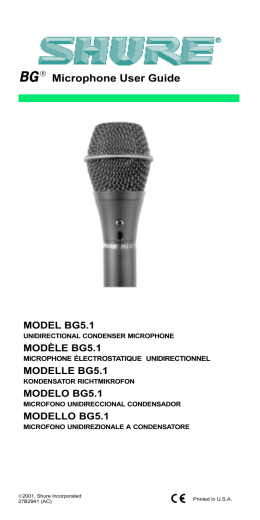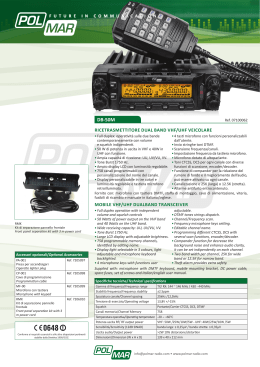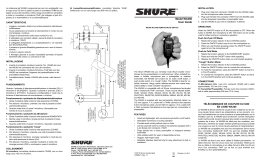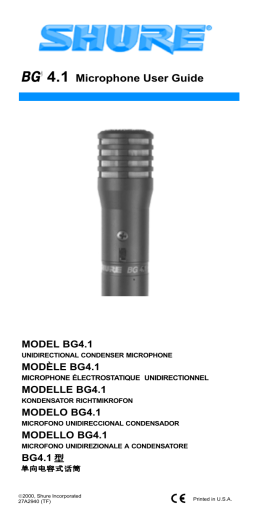Model SM58® User Guide APPLICATION TONE QUALITY Lead & Backup Vocals Lips less than 150 mm (6 in.) away or touching the windscreen, on axis to microphone. Robust sound, emphasized bass, maximum isolation from other sources. Speech 150 mm (6 in.) to .6 m (2 ft) away Natural sound, from mouth, just above nose reduced bass. height. 200 mm (8 in.) to .6 m (2 ft) away Natural sound, from mouth, slightly off to one reduced bass and side. minimal “s” sounds. GENERAL The Shure SM58® is a unidirectional (cardioid) dynamic vocal microphone for professonal vocal use in sound reinforcement and studio recording. A highly effective, built-in, spherical filter minimizes wind and breath “pop” noise. A cardioid pickup pattern isolates the main sound source while minimizing unwanted background noise. The SM58 has a tailored vocal response for a sound which is a world standard. Rugged construction, a proven shock mount system, and a steel mesh grille ensure that even with rough handling, the SM58 will perform consistently. Outdoors or indoors, singing or speech, the SM58 is the overwhelming choice of professionals worldwide. SUGGESTED MICROPHONE PLACEMENT 1 m (3 ft) to 2 m (6 ft) away. Thinner; distant sound; ambience. STAGE MONITOR & P.A. LOUDSPEAKER PLACEMENT Place the stage monitor directly behind the microphone (see Figure 1). Locate the P.A. loudspeakers so that they point away from the rear of the microphone. With the speakers located in these positions, the possibility of feedback is greatly reduced. Always check the stage setup before a performance to ensure optimum placement of microphone and monitors . STAGE MONITOR Features • Frequency response tailored for vocals, with brightened midrange and bass rolloff • Uniform cardioid pickup pattern isolates the main sound source and minimizes background noise • Pneumatic shock-mount system cuts down handling noise • Effective, built-in spherical wind and pop filter • Supplied with break-resistant stand adapter which rotates 180° • Legendary Shure quality, ruggedness, and reliability Variations SM58 SM58S (With On/Off Switch) PROXIMITY EFFECT When the sound source is less than 6 mm (1/4 in.) from the microphone, the microphone boosts bass frequencies (by 6 to 10 dB at 100 Hz), creating a warmer and richer bass sound than when farther away. This effect, known as proximity effect, happens only in unidirectional microphones like the SM58. The SM58 low-frequency roll-off provides greater control, allowing the user to take full advantage of proximity effect. APPLICATIONS AND PLACEMENT The SM58 is ideal for close-up vocals and can be held in the hand or mounted on a stand. Some of the most common applications and placement techniques are listed in the following table. Keep in mind that microphone technique is largely a matter of personal taste—there is no one “correct” microphone position. ©2006, Shure Incorporated 27B2902 (Rev. 3) P.A. LOUDSPEAKERS MICROPHONE SOUND SOURCE RECOMMENDED LOUDSPEAKER PLACEMENT FIGURE 1 GENERAL RULES FOR MICROPHONE USE 1. Aim the microphone toward the desired sound source and away from unwanted sources. 2. Locate the microphone as close as practical to the desired sound source. 3. Work close to the microphone for extra bass response. 4. Use only one microphone per sound source. 5. Locate microphones at least three times as far from other microphones as from the sound source. 6. Use as few microphones as practical. 7. Place microphones far from sound-reflecting surfaces. 8. Add a windscreen when using the microphone outdoors, for closeup speech, or vocals. 9. Avoid excessive handling to minimize mechanical noise. Printed in U.S.A. SPECIFICATIONS Overall Dimensions (Figure 5) Type Dynamic (moving coil) Frequency Response 50 to 15,000 Hz (see Figure 2) OVERALL DIMENSIONS FIGURE 5 Swivel Adapter Positive-action, break-resistant, adjustable through 180°, with standard 5/8 in.-27 thread Net Weight 298 grams (10.5 oz) TYPICAL FREQUENCY RESPONSE FIGURE 2 CERTIFICATION Eligible to bear CE Marking. Conforms to European EMC Directive 89/336/EEC. Meets applicable tests and performance criteria in European Standard EN55103 (1996) parts 1 and 2, for residential (E1) and light industrial (E2) environments. Polar Pattern Unidirectional (cardioid), rotationally symmetrical about microphone axis, uniform with frequency (see Figure 3) 180° 180° 150° 150° 150° 120° 120° 90° 90° FURNISHED ACCESSORIES 120° 120° Swivel Stand Adapter .................................................... A25D Storage Bag ................................................................. 26A13 90° 90° –20 dB –20 dB –15 dB 60° 150° –15 dB 60° –10 dB 60° OPTIONAL ACCESSORIES 60° –10 dB –5 dB –5 dB 30° 30° Windscreen ...................... A58WS Series (8 colors available) Desk Stand..........................................................S37A, S39A Isolation Mount.............................................................. A55M Dual Mount.................................................................... A26M Cable, 7.6 m (25 ft) ............................................C25E, C25F 30° 30° 0 0 125 Hz 2000 Hz 500 Hz 4000 Hz 1000 Hz 8000 Hz TYPICAL POLAR PATTERNS FIGURE 3 Sensitivity (at 1,000 Hz Open Circuit Voltage) –54.5 dBV/Pa (1.85 mV) 1 Pa = 94 dB SPL Impedance Rated impedance is 150Ω (300Ω actual) for connection to microphone inputs rated low impedance Polarity Positive pressure on diaphragm produces positive voltage on pin 2 with respect to pin 3 Internal Connections (Figure 4) REPLACEMENT PARTS Cartridge ..........................................................................R59 Screen and Grille Assembly......................................RK143G For additional technical assistance, phone Shure at 1-847-600-8440. In Europe, phone 49-7131-72140. CARTRIDGE SWITCH (SM58S ONLY) CODED TERMINAL GREEN GREEN YELLOW YELLOW BLUE RED BLACK TRANSFORMER INTERNAL CONNECTIONS FIGURE 4 Connector Three-pin professional audio connector (male XLR type) Case Dark gray, enamel-painted, die cast metal; matte-finished, silver colored, spherical steel mesh grille 2 MODÈLE SM58® APPLICATION MICROPHONE DYNAMIQUE UNIDIRECTIONNEL Le Shure SM58 est un microphone vocal dynamique unidirectionnel (cardioïde) conçu pour la sonorisation et l'enregistrement de la voix. Un filtre sphérique à haute efficacité minimalise les bruits de vent, de respiration et de bouche. Une configuration cardioïde isole la source sonore principale tout en réduisant les bruits de fond indésirables. La courbe de réponse vocale du SM58 lui confère une sonorité qui est devenue le critère d'excellence mondial. Une construction robuste, un système de monture antichocs éprouvé et une grille en acier inoxydable assurent une fonctionnement sans faille, même dans les conditions les plus rigoureuses. Que ce soit pour la salle ou le plein air, le chant ou la parole, le SM58 est le choix de prédilection des professionnels des quatre coins du globe. PLACEMENT SUGGÉRÉ SONORITÉ Chanteurs et choristes Lèvres à moins de 15 cm ou touchant le coupe-vent, dans l'axe du micro. Son robuste, basses accentuées, isolation maximum d'autres sources sonores. Parole 15 à 50 cm de la bouche, juste Son naturel, basau-dessus de la base du nez ses réduites 20 à 50 cm de la bouche légè- Son naturel, basrement hors axe ses réduites, sifflements des “s” minimum 1 à 2 m de distance Petit son, distant, ambiance. DISPOSITION DES RETOURS DE SCÈNE ET DES HAUTS-PARLEURS DE SONORISATION Avantages Placer le retour directement derrière le microphone (voir la figure 1). Disposer les hauts-parleurs de sonorisation de manière à ce qu'ils soient tournés à l'opposé de l'arrière du microphone pour réduire au maximum les risques de Larsen. Toujours vérifier la mise en place de la scène pour s'assurer que la disposition des microphones et haut-parleurs est optimale. • Gamme de fréquences adaptée à la voix avec médiums extra/clairs et limiteur de basses • Configuration cardioïde uniforme isolant la source sonore principale et minimalisant le bruit de fond • Système antichocs pneumatique réduisant la transmission des bruits de manipulation • Filtre sphérique efficace contre les bruits de vent et de bouche • Adaptateur de pied incassable pivotant sur 180° inclus • Qualité et fiabilité légendaires de Shure RETOUR HAUTPARLEURS Variations MICROPHONE SM58 SM58S (avec interrupteur d'alimentation electrique) SOURCE SONORE PLACEMENT RECOMMANDÉ POUR LES HAUT-PARLEURS FIGURE 1 EFFET DE PROXIMITÉ Lorsque la source sonore se trouve à moins de 6 mm du microphone, les basses fréquences sont augmentées de 6 à 10 dB, à 100 Hz, produisant un son plus chaud et plus puissant. Ce phénomène, connu sous le nom d'effet de proximité, est exclusif aux microphones unidirectionnels tels que le SM58. L'atténuation de basses fréquences du SM58 assure un meilleur contrôle et permet à l'utilisateur de mieux tirer parti de l'effet de proximité. RÈGLES GÉNÉRALES D'UTILISATION DE MICROPHONES 1. Diriger le micro vers la source sonore, le plus à l'écart possible des bruits indésirables. 2. Placer le microphone aussi près que possible de la source sonore. 3. Plus la source sonore est proche du micro, plus les basses sont présentes. 4. N'utiliser qu'un microphone par source sonore. 5. La distance entre les microphones doit être d'au moins trois fois celle de chaque micro à sa source sonore respective. 6. Utiliser le moins de microphones possible. 7. Placer les microphones aussi loin que possible des surfaces réfléchissantes. 8. Utiliser un coupe-vent si les microphones sont utilisés à l'extérieur. 9. Éviter les manipulations inutiles pour minimiser le captage des bruits mécaniques. APPLICATIONS ET PLACEMENT Le SM58 est idéal pour la prise de son vocale de près et peut être tenu à la main ou monté sur pied. Quelques-unes des applications et techniques de placement les plus courantes sont expliquées dans le tableau ci-dessous. Ne pas oublier que la technique de placement des micros est surtout une question de goût personnel et qu'il n'y a pas de position “correcte”. 3 CARACTÉRISTIQUES Dimensions hors tout (voir la figure 5) Type Dynamique (à bobine mobile) Courbe de réponse 50 à 15 000 Hz (voir la figure 2) DIMENSIONS HORS TOUT FIGURE 5 Adaptateur de pied pivotant À emboîtement, incassable, réglable de 0 à 180° avec filet standard de 5/8"-27 Poids net 298 grammes COURBE DE RÉPONSE TYPIQUE FIGURE 2 Courbe de directivité Unidirectionnelle (cardioïde), rotativement symétrique autour de l'axe du microphone, constante avec la féquence (voir la figure 3) 180° Autorisé à porter la marque CE. Conforme à la directive CEM européenne 89/336/CEE. Conforme aux critères applicables de test et de performances de la norme européenne EN 55103 (1996) parties 1 et 2 pour les environnements résidentiels (E1) et d'industrie légère (E2). 180° 150° 150° 150° 120° 120° 90° 90° 150° 120° 120° ACCESSOIRES FOURNIS 90° 90° –20 dB –20 dB –15 dB 60° Homologation Adaptateur de pied pivotant ........................................... A25D Étui de rangement ........................................................ 26A13 –15 dB 60° –10 dB 60° 60° –10 dB –5 dB –5 dB 30° 30° 30° 30° 0 0 125 Hz ACCESSOIRES EN OPTION 2000 Hz 500 Hz 4000 Hz 1000 Hz 8000 Hz Coupe-vent ................. Série A58WS (8 couleurs disponibles) Support de table .................................................S37A, S39A Monture isolante ............................................................ A55M Double monture ............................................................. A26M Câble de 7,6 m ...................................................C25E, C25F COURBES DE DIRECTIVITÉ TYPIQUES FIGURE 3 Niveau de sortie (à 1000 Hz) Tension en circuit ouvert : –54,5 dBV/Pa (1,85 mV) 1 Pa = 94 dB SPL Impédance L'impédance nominale est de 150Ω (300Ω réelle) pour connexion aux entrées de micros basse impédance Phase Une pression positive sur le diaphragme produit une tension positive sur la broche 2 par rapport à la broche 3 Connexions internes (voir la figure 4) PIÈCES DE RECHANGE Cartouche .........................................................................R59 Ensemble grille et coupe-vent ...................................RK143G Pour des informations plus détaillées sur les réparations ou les pièces de rechange, contacter le service après-vente de Shure, au 1-800-516-2525. Hors des États-Unis contacter le centre de réparations agréé de Shure. CARTOUCHE COMMUTATEUR (SM58S SELULEMENT) VERT JAUNE CODÉE GREEN BLEU JAUNE ROUGE NOIR TRANSFORMATEUR CONNEXIONS INTERNES FIGURE 4 Connecteur Connecteur professionnel 3 broches (mâle, type XLR) Corps Acier moulé émaillé gris foncé avec grille sphérique en acier argent mat 4 MODELL SM58® EMPFOHLENE MIKROPHONAUFSTELLUNG TONQUALITÄT UNIDIREKTIONALES DYNAMISCHES MIKROPHON ANWENDUNG Beim Shure SM58 handelt es sich um ein unidirektionales dynamisches (Nieren-) Gesangsmikrophon, das für professionelle Tonverstärkung und Tonstudioaufnahmen entwickelt wurde. Ein eingebauter, hochwirksamer sphärischer Filter minimiert Windgeräusche und Popplaute- Geräusche. Die Nieren-Aufnahmecharakteristik isoliert die Haupttonquelle und reduziert zugleich unerwünschte Hintergrundgeräusche auf ein Minimum. Der Frequenzgang des SM58 wurde speziell auf Gesangsstimmen abgestimmt, wodurch es zu den weltweit führendon Mikrophonen gehört. Die robuste Ausführung, ein bewährtes Dämpfer-System und ein Stahlgittergrill stellen sicher, daß das SM58 auch bei rauher Behandlung mit unveränderlicher Zuverlässigkeit funktioniert. Sei es im Freien oder in Räumen, für Gesang oder Sprache-weltweit entscheiden sich immer mehr Profis für das SM58. Haupt- und Hintergrundsänger Weniger als 15 cm Abstand vom Mund oder Berührung des Windschalterfilter, axial zum Mikrophon. Sprache 15 bis 50 cm Abstand vom Mund, Natürlicher Klang, etwas oberhalb der Nasenhöhe. reduzierter Baß. Robuster Klang, hervorgehobener Baß, maximale Isolierung von anderen Quellen. 20 bis 50 cm Abstand vom Mund, Natürlicher Klang, etwas zur Seite geneigt. reduzierter Baß und minimale Zischlaute. 1 bis 2 m Abstand. Dünnerer, entfernterer Klang; Umgebungsgeräusche. AUFSTELLUNG DER BÜHNENLAUTSPRECHER UND LAUTSPRECHER FÜR BESCHALLUNGSANLAGE Merkmale • Auf Gesangsaufnahmen zugeschnittener Frequenzgang, mit aufgehelltem Mittenbereich und Baßdämpfung • Gleichförmige Nieren-Aufnahmecharakteristik isoliert die Haupttonquelle und reduziert zugleich Hintergrundgeräusche auf ein Minimum • Pneumatisches Dämpfer-System verringert Handhabungsgeräusche • Wirksamer, eingebauter sphärischer Wind- und Poppfilter • Mit einem bruchfesten, um 180° drehbaren Stativadapter ausgestattet • Bewährte Shure Qualität, Robustheit und Zuverlässigkeit Den Bühnenlautsprecher direkt hinter dem Mikrophon aufstellen (siehe Abbildung 1). Die Lautsprecher der Beschallungsanlage so plazieren, daß sie von der Rückseite des Mikrophons wegzeigen. Wenn sich die Lautsprecher an diesen Stellen befinden, wird das Risiko von Rückkopplungen stark reduziert. Vor einem Auftritt stets die Bühnenausstattung überprüfen, um eine optimale Aufstellung der Mikrophone und Lautsprecher sicherzustellen. BÜHNENLAUTSPRECHER Variations SM58 SM58S (mit netz [power] ein/aus-knopf) NAHBESPRECHUNGSEFFEKT MIKROPHON Wenn die Tonquelle weniger als 6 mm vom Mikrophon entfernt ist, verstärkt das Mikrophon Baßfrequenzen (um 6 bis 10 dB bei 100 Hz), wodurch ein wärmerer und reicherer Baßklang als bei größeren Entfernungen erzeugt wird. Dieser Effekt, der als Nahbesprechungseffekt bezeichnet wird, tritt nur bei unidirektionalen Mikrophonen wie dem SM58 auf. Das allmähliche Dämpfungsverhalten des SM58 bei niedrigen Frequenzen bietet eine bessere Regelung und ermöglicht dem Benutzer, den Nahbesprechungseffekt voll auszunutzen. TONQUELLE LAUTSPRECHER DER BESCHALLUNGSANLAGE EMPFOHLENE LAUTSPRECHERAUFSTELLUNG ABBILDUNG 1 ALLGEMEINE REGELN FÜR DEN MIKROPHONGEBRAUCH 1. Das Mikrophon auf die gewünschte Tonquelle und weg von unerwünschten Quellen richten. 2. Das Mikrophon so nahe wie möglich an die gewünschte Tonquelle heranbringen. 3. Abstand verringern, wenn zusätzliches Baßverhalten gewünscht wird. 4. Je Tonquelle nur ein Mikrophon verwenden. 5. Die Mikrophone mindestens dreimal so weit von einander entfernt aufstellen wie von der Tonquelle. 6. So wenig Mikrophone wie möglich verwenden. 7. Mikrophone weit entfernt von Akustikflächen anbringen. 8. Einen Windschirm anbringen, wenn das Mikrophon im Freien verwendet wird; das gilt sowohl für Sprach- als auch für Gesangsaufnahmen. 9. Mikrophone so wenig wie möglich anfassen, um mechanische Geräusche zu vermeiden. ANWENDUNG UND AUFSTELLUNG Das SM58 ist ideal für Nahaufnahmen von Gesang und kann mit der Hand gehalten oder an einem Stativ angebracht werden. Einige der gebräuchlichsten Anwendungen und Aufstellungsverfahren für das SM57 sind in der nachfolgenden Tabelle aufgeführt. Beachten Sie bitte, daß der Mikrophoneinsatz weitgehend eine “Geschmackssache“ ist - von “richtigen“ oder “falschen“ Mikrophonpositionen kann hier also nicht die Rede sein. 5 SPEZIFIKATIONEN Gesamtabmessungen Typ Dynamisch (Tauchspule) Frequenzgang 50 bis 15.000 Hz (siehe Abbildung 2) GESAMTABMESSUNGEN ABBILDUNG 5 Schwenkadapter Formschlüssig, bruchfest, bis 180° verstellbar, mit 5/8 Inch-27 Standardgewinde Nettogewicht 298 Gramm TYPISCHER FREQUENZGANG ABBILDUNG 2 ZERTIFIZIERUNG Zur CE-Kennzeichnung berechtigt. Entspricht der EU-Richtlinie über elektromagnetische Verträglichkeit 89/336/EEC. Erfüllt die Prüfungs- und Leistungskriterien der europäischen Norm EN 55103 (1996) Teil 1 und 2 für Wohngebiete (E1) und Leichtindustriegebiete (E2). Polarcharakteristik Unidirektionale (Nieren-) Charakteristik, rotationssymmetrisch um Mikrophonachse, gleichförmig mit Frequenz (siehe Abbildung 3) 180° 150° 150° 120° 120° 150° –20 dB –15 dB –15 dB 60° SONDERZUBEHÖR 90° 90° –20 dB –10 dB Schwenkstativadapter ................................................... A25D Tasche.......................................................................... 26A13 120° 120° 90° 90° 60° MITGELIEFERTES ZUBEHÖR 180° 150° 60° –5 dB Windschalterfilter.......... Serie A58WS (in 8 Farben erhältlich) Tischstativ ...........................................................S37A, S39A Isolierbefestigung .......................................................... A55M Doppelbefestigung ........................................................ A26M Kabel (7,6 m).......................................................C25E, C25F 60° –10 dB –5 dB 30° 30° 30° 30° 0 0 125 Hz 2000 Hz 500 Hz 4000 Hz 1000 Hz 8000 Hz TYPISCHE POLARCHARAKTERISTIK ABBILDUNG 3 ERSATZTEILE Kapsel ..............................................................................R59 Schirm- und Grill-Baugruppe.....................................RK143G Ausgangspegel (bei 1000 Hz) Leerlaufspannung: -54,5 dBV/Pa (1,85 mV) 1 Pa = 94 dB SPL Impedanz Die Nennimpedanz für den Anschluß an niederohmige Mikrophoneingänge beträgt 150Ω (Ist-Wert 300Ω). Phasenabgleich Positiver Druck auf die Membran erzeugt positive Spannung an Stift 2 gegenüber Stift 3. Interne Schaltungen SCHALTER (SM58S EINZIG) GRÜN GELB Weitere Informationen über Service oder Ersatzteile erhalten Sie von der Shure Kundendienstabteilung unter der Telefonnummer 1-800-516-2525. Außerhalb der Vereinigten Staaten wenden Sie sich bitte an Ihr Shure Vertragskundendienstzentrum. KAPSEL GEKENNZEICHNET GRÜN BLAU GELB ROT SCHWARZ KRAFTTRANSFORMATOR INTERNE SCHALTUNGEN ABBILDUNG 4 Stecker Dreipoliger Profi-XLR-stecker Gehäuse Dunkelgraues einbrennlackiertes Druckgußmetall, kugelförmiger, silberfarbener Stahlgittergrill in matter Ausführung 6 MODELO SM58® USO MICROFONO DINAMICO UNIDIRECCIONAL COLOCACION SUGERIDA DEL MICROFONO Voces princi- Los labios a no más de 15 cm pales y de o tocando al paravientos, en lífondo nea con el eje de captación del micrófono. El Shure SM58 es un micrófono dinámico unidireccional (cardioide) diseñado para vocalistas profesionales en situaciones de refuerzo de sonido y grabaciones en estudio. Su filtro esférico incorporado altamente eficaz reduce al mínimo los ruidos causados por el viento y por el aliento. El dispersión polar de cardioide aísla la fuente sonora principal a la vez que reduce al mínimo los ruidos de fondo. El SM58 tiene una respuesta ajustada para la captación de voces que produce una calidad de sonido que se ha convertido en la norma a nivel mundial. Su fabricación resistente, su comprobado sistema de montaje resistente a choques y su rejilla de malla de acero garantizan que aún en condiciones de mal trato al aparato, el SM58 dará un rendimiento consistente. Ya sea a la intemperie o bajo techo, para cantantes o para oradores—el SM58 es la elección de la gran mayoría de los profesionales del mundo entero. Conferencias CALIDAD DEL TONO Sonido robusto, frecuencias bajas enfatizadas, aislamiento máximo de otras fuentes sonoras. De 15 a 50 cm de la boca, justo Sonido natural, arriba del nivel de la nariz. frecuencias bajas reducidas. De 20 a 50 cm de la boca, lige- Sonido natural, ramente a un lado de ésta. frecuencias bajas reducidas y pocos sonidos sibilantes. De 1 a 2 m de distancia. Sonido más agudo y distante; sonido ambiental. COLOCACION DE ALTAVOCES DE PA MONITOR DE ESCENARIO Características • Respuesta de frecuencia diseñada para la voz humana con aumento de frecuencias medias y atenuación progresiva de bajas frecuencias • La dispersión polar cardioide uniforme aisla la fuente sonora principal a la vez que reduce al mínimo los ruidos de fondo • El sistema de montaje neumático resistente a choques reduce los ruidos causados por el manejo • Filtro esférico incorporado altamente eficaz para reducir los ruidos causados por el viento y por el aliento • Incluye un adaptador de pedestal resistente a las roturas que gira 180° • La legendaria calidad, robustez y fiabilidad de Shure Coloque el monitor de escenario directamente detrás del micrófono (vea la Figura 1). Coloque los altavoces de P.A. de manera que el sonido que emiten se aleje de la parte trasera del micrófono. Cuando los altavoces se colocan en estas posiciones, la posibilidad realimentación se reduce significativamente. Siempre compruebe la disposición del escenario antes de una actuación para verificar que la colocación del micrófono y los monitores es la óptima. MONITOR DE ESCENARIO ALTAVOCES DE P.A. Variaciones SM58 SM58S (con interruptor de encendido) MICROFONO EFECTO DE PROXIMIDAD FUENTE SONORA COLOCACION RECOMENDADA DE LOS ALTAVOCES FIGURA 1 Cuando la fuente sonora se encuentra a menos de 6 mm del micrófono, éste introduce un aumento progresivo en las frecuencias bajas (de 6 a 10 dB a 100 Hz) que crea un sonido de frecuencias bajas más cálido y fuerte que cuando la fuente está más alejada. Este efecto, conocido como el efecto de proximidad, se produce únicamente en micrófonos unidireccionales tales como el SM58. La atenuación progresiva de frecuencias bajas que incorpora el SM58 ofrece mayor control sobre el sonido y ayuda al usuario a aprovechar el efecto de proximidad. REGLAS GENERALES DE USO DE MICROFONOS 1. Apunte el micrófono hacia la fuente sonora deseada y alejado de las fuentes no deseadas. 2. Coloque el micrófono lo más cerca posible a la fuente sonora deseada. 3. Acérquese al micrófono para obtener mayor respuesta de frecuencias bajas. 4. Utilice sólo un micrófono para captar una fuente sonora. 5. La distancia entre un micrófono y otro deberá ser al menos tres veces la distancia de cada fuente a su micrófono. 6. Utilice el menor número de micrófonos que resulte práctico. 7. Aleje los micrófonos lo más posible de las superficies reflectoras. 8. Instale un paravientos si se usa el micrófono a la intemperie, o al captar una voz a muy poca distancia. 9. Evite el manejo excesivo para reducir la captación de ruidos mecánicos. USOS Y COLOCACION El SM58 es ideal para captar voces a corta distancia y puede sostenerse en la mano o en un pie. Algunas de las técnicas más comunes de uso y colocación se indican en la tabla siguiente. Recuerde que la técnica de uso de los micrófonos es en gran parte cuestión de gusto personal—no existe una posición de micrófono que sea la "correcta". 7 ESPECIFICACIONES Dimensiones totales Tipo Dinámico (bobina móvil) Respuesta de frecuencia 50 a 15.000 Hz (vea la Figura 2) DIMENSIONES TOTALES FIGURA 5 Adaptador giratorio De acción positiva, resistente a roturas, 180° de ajuste con rosca estándar de 5/8 pulg-27 Peso neto 298 g (10,5 oz) RESPUESTA DE FRECUENCIA TIPICA FIGURA 2 Dispersión polar Unidireccional (cardioide), simétrico respecto al eje del micrófono, uniforme respecto a la frecuencia (vea la Figura 3) 180° Califica para llevar las marcas CE. Cumple la directiva europea 89/336/EEC de compatibilidad electromagnética. Se ajusta a los criterios correspondientes de verificación y funcionamiento establecidos en la norma europea EN 55103 (1996), partes 1 y 2, para zonas residenciales (E1) y zonas de industria ligera (E2). 180° 150° 150° 150° 120° 120° 150° 120° 120° 90° 90° 60° CERTIFICACIONES 90° 90° –20 dB –20 dB –15 dB –15 dB 60° –10 dB 60° –5 dB ACCESORIOS SUMINISTRADOS 60° –10 dB Adaptador giratorio ........................................................ A25D Bolsa de almacenamiento ............................................ 26A13 –5 dB 30° 30° 30° 30° 0 0 125 Hz 2000 Hz 500 Hz 4000 Hz 1000 Hz 8000 Hz ACCESORIOS OPCIONALES DISPERSIONES POLAR TIPICAS FIGURA 3 Paravientos................Serie A58WS (disponible en 8 colores) Pie de sombremesa.............................................S37A, S39A Montaje con aislamiento ................................................ A55M Montaje doble ................................................................ A26M Cable (7,6 m [25 pies]) ........................................C25E, C25F Nivel de salida (a 1.000 Hz) Voltaje de circuito abierto: -54,5 dBV/Pa (1,85 mV) 1 Pa = 94 dB SPL Impedancia La impedancia nominal es de 150Ω (real: 300Ω) para conexión a entradas de micrófono de baja impedancia. Fase Una presión positiva en el diafragma del micrófono produce una tensión positivo en la patilla 2 con respecto a la patilla 3 Conexiones internas INTERRUPTOR (SM58S SOLAMENTE) REPUESTOS Cartucho ...........................................................................R59 Conjunto de malla y rejilla..........................................RK143G Para información adicional acerca del servicio o repuestos, llame al Departamento de servicio Shure al teléfono 1-800-5162525. Fuera de los EE.UU., llame al servicentro autorizado de productos Shure. CAPSULA DE CODIGO VERDE AMARILLO VERDE AZUL AMARILLO ROJO NEGRO TRANFORMADOR CONEXIONES INTERNAS FIGURA 4 Conector Conector de audio de tres patillas profesional (tipo XLR macho) Caja Metal fundido a troquel esmaltado de color gris oscuro con rejilla esférica de acero con acabado mate de color plateado 8 MODELLO SM58® APPLICAZIONE MICROFONO DINAMICO UNIDIREZIONALE Il modello SM58 della Shure è un microfono dinamico unidirezionale (cardioide) per applicazioni vocali realizzato per l'utilizzo in studi di registrazione ed impianti di amplificazione professionali. Un filtro sferico incorporato molto efficace riduce al minimo il rumore del vento e l'effeto pop. Il diagramma polare a cardioide isola la sorgente sonora principale e simultaneamente riduce al minimo il rumore di fondo indesiderato. Il microfono SM58 presenta una risposta vocale ottimizzata per a fornire un suono la cui qualità costituisce uno standard mondiale. La robustezza della fabbricazione, il comprovato sistema di supporto antivibrazione e la griglia in acciaio inossidabile ne garantiscono la costanza delle prestazioni, anche quando lo si maneggia senza delicatezza. Sia all'aperto che in interni, per canto od o parlato - l' SM58 è, a schiacciante maggioranza, il microfono scelto dai professionisti in tutto il mondo. COLLOCAZIONE DEL MICROFONO SUGGERITA Cantanti e coro Bocca a meno di 15 cm dal microfono o a contatto con la griglia, lungo l'asse del microfono. Parlato QUALITÀ DEI TONI Suono robusto, enfasi sui toni bassi, massimo isolamento da altre sorgenti. Distanza dalle bocca compresa Suono naturale, tra 15 e 50 cm, ad un'altezza ap- toni bassi ridotti. pena superiore a quella del naso. Distanza dalle bocca compresa Suono naturale, tra 20 e 50 cm, leggermente fuori toni bassi ridotti e asse sull'uno o l'altro lato. suoni sibilanti ridotti al minimo. Distanza compresa tra 1 e 2 m. Suono lontano e sfumato; rumore ambientale. COLLOCAZIONE DEGLI ALTOPARLANTI PER IL PUBBLICO E DEL MONITOR DI PALCO Caratteristiche Collocare l'altoparlante di controllo del palcoscenico direttamente dietro il microfono (vedi Figura 1). Collocare gli altoparlanti per il pubblico in modo che siano rivolti in direzione opposta rispetto alla parte posteriore del microfono. Con tale disposizione degli altoparlanti si riduce enormemente la possibilità di feedback. Prima della rappresentazione, controllare sempre l'allestimento del palcoscenico per verificare la collocazione ottimale del microfono e degli altoparlanti di controllo. • Risposta in frequenza ottimizzata per applicazioni vocali, con maggiore chiarezza alle frequenze intermedie e attenuazione alle basse frequenze. • Diagramma polare a cardioide uniforme, che isola la sorgente sonora principale e riduce al minimo il rumore di fondo. • Sistema pneumatico di supporto antivibrazione che riduce il rumore derivante dal maneggiamento. • Efficace filtro sferico incorporato, antipop e antivento. • Include un adattatore per supporto, resistente a rotture accidentali, orientabile a 180°. • Le leggendarie qualità, robustezza e affidabilità Shure. MONITOR DI CONTROLLO Variaziones SM58 SM58S (con interruttore di alimentazione ON/OFF) MICROFONO SORGENTE SONORA ALTOPARLANTI PER IL PUBBLICO EFFETTO DI PROSSIMITÀ Quando la sorgente sonora si trova a meno di 6 mm di distanza dal microfono, la risposta alle basse frequenze aumenta progressivamente (da 6 a 10 dB a 100 Hz), generando un suono dei toni bassi più ricco e caldo rispetto a distanze maggiori della sorgente stessa dal microfono. Questo fenomeno, noto come effetto di prossimità, si verifica solo in microfoni unidirezionali come il modello SM58. L'attenuazione alle basse frequenze dell'SM58 fornisce un controllo maggiore e consente a chi usa il microfono di sfruttare pienamente l'effetto di prossimità. COLLOCAZIONE SUGGERITA DEGLI ALTOPARLANTI FIGURA 1 REGOLE GENERALI PER L'USO DEL MICROFONO 1. Rivolgere il microfono verso la sorgente sonora desiderata e lontano da sorgenti indesiderate. 2. Collocare il microfono quanto più vicino possibile alla sorgente sonora desiderata. 3. Per ottenere una maggiore risposta ai toni bassi, tenere il microfono vicino a bocca. 4. Usare solo un microfono per ciascuna sorgente sonora. 5. Mantenere la distanza tra più microfoni ad un valore uguale ad almeno tre volte la distanza tra ciascun microfono e la sorgente sonora. 6. Usare il numero minimo di microfoni consentito dall'applicazione. 7. Collocare i microfoni quanto più lontano possibile da superfici fonoriflettenti. 8. Quando si usa il microfono all'aperto, per cantanti od oratori a distanza ravvicinata, utilizzare uno schermo antivento. 9. Evitare movimenti eccessivi del microfono, per ridurre il rumore di maneggiamento. APPLICAZIONI E COLLOCAZIONE Il modello SM58, ideale per applicazioni vocali a distanza ravvicinata, può essere tenuto in mano o montato su un supporto. La tabella che segue ne riporta le più comuni applicazioni e tecniche di collocazione. Rammentare sempre che le tecniche microfoniche dipendono largamente dalle preferenze personali e che non esiste una unica posizione "giusta" del microfono. 9 DATI TECNICI Dimensioni totali Tipo Dinamico (a bobina mobile) Risposta in frequenza Da 50 a 15.000 Hz (vedi Figura 2) DIMENSIONI TOTALI FIGURA 5 Adattatore regolabile Senza slittamento, resistente a sollecitazioni da rottura, regolabile in un angolo di 180°, con filettatura standard 5/8" - 27. Peso netto 298 g RISPOSTA IN FREQUENZA TIPICA FIGURA 2 CERTIFICAZIONI Diagramma polare Unidirezionale (cardioide) con simmetria rotazionale rispetto all'asse del microfono, uniforme con la frequenza (vedi Figura 3). 180° Contrassegnabile con il marchio CE. Conforme alla direttiva europea sulla compatibilità elettromagnetica 89/336/CEE. Conforme ai criteri sulle prestazioni e alle prove pertinenti specificati nella norma europea EN 55103 (1996) parti 1 e 2, per ambienti residenziali (E1) e industriali leggeri (E2). 180° 150° 150° 150° 120° 120° 150° 120° 120° ACCESSORI IN DOTAZIONE 90° 90° –20 dB –20 dB –15 dB 60° Adattatore regolabile...................................................... A25D Borsa ............................................................................ 26A13 90° 90° –15 dB 60° –10 dB 60° 60° –10 dB –5 dB OPTIONAL –5 dB 30° 30° 30° 30° 0 Schermo antivento........ Serie A58WS (disponibile in 8 colori) Base da tavolo .....................................................S37A, S39A Adattore antivibrazioni ................................................... A55M Adattore doppio ............................................................. A26M Cavo (7,6 m) ........................................................C25E, C25F 0 125 Hz 2000 Hz 500 Hz 4000 Hz 1000 Hz 8000 Hz DIAGRAMMI POLARI TIPICI FIGURA 3 Livelli di uscita (a 1.000 Hz) Tensione a circuito aperto: –54,5 dBV/Pa (1,85 mV) 1 Pa = 94 dB SPL Impedenza Valore nominale: 150Ω (300Ω effettivi) per il collegamento a ingressi microfonici con bassi valori nominali di impedenza. Relazione di fase Una pressione positiva sul diaframma produce una tensione positiva al piedino 2 rispetto al piedino 3. Collegamenti interni INTERRUTORE (SM58S SOLO) VERDE GIALLO RICAMBI Cartuccia...........................................................................R59 Gruppo griglia e schermo ..........................................RK143G Per ulteriori informazioni sui ricambi o per assistenza, chiamare l'assistenza clienti della Shure al numero verde 1-800-516-2525 (solo negli Stati Uniti). Fuori dagli Stati Uniti rivolgersi al rivenditore o ad un centro di assistenza autorizzato. CARTUCCIA CODICE VERDE BLU GIALLO ROSSO NERO TRANSFORMATORE COLLEGAMENTI INTERNI FIGURA 4 Connettore Connettore audio professionale a tre piedini (tipo XLR maschio). Contenitore Corpo in metallo pressofuso, grigio scuro, smaltato; griglia sferica in acciaio inossidabile, colore argento con finitura opaca. 10 11 180° 180° 150° 150° 150° 120° 120° 90° 90° 60° 150° 120° 120° 90° 90° –20 dB –20 dB –15 dB –15 dB 60° –10 dB 60° 60° –10 dB –5 dB –5 dB 30° 30° 0 30° 30° 0 125 Hz 2000 Hz 500 Hz 4000 Hz 1000 Hz 8000 Hz SHURE Incorporated http://www.shure.com United States, Canada, Latin America, Caribbean: 5800 W. Touhy Avenue, Niles, IL 60714-4608, U.S.A. Phone: 847-600-2000 U.S. Fax: 847-600-1212 Intl Fax: 847-600-6446 Europe, Middle East, Africa: Shure Europe GmbH, Phone: 49-7131-72140 Fax: 49-7131-721414 Asia, Pacific: Shure Asia Limited, Phone: 852-2893-4290 Fax: 852-2893-4055
Scarica
